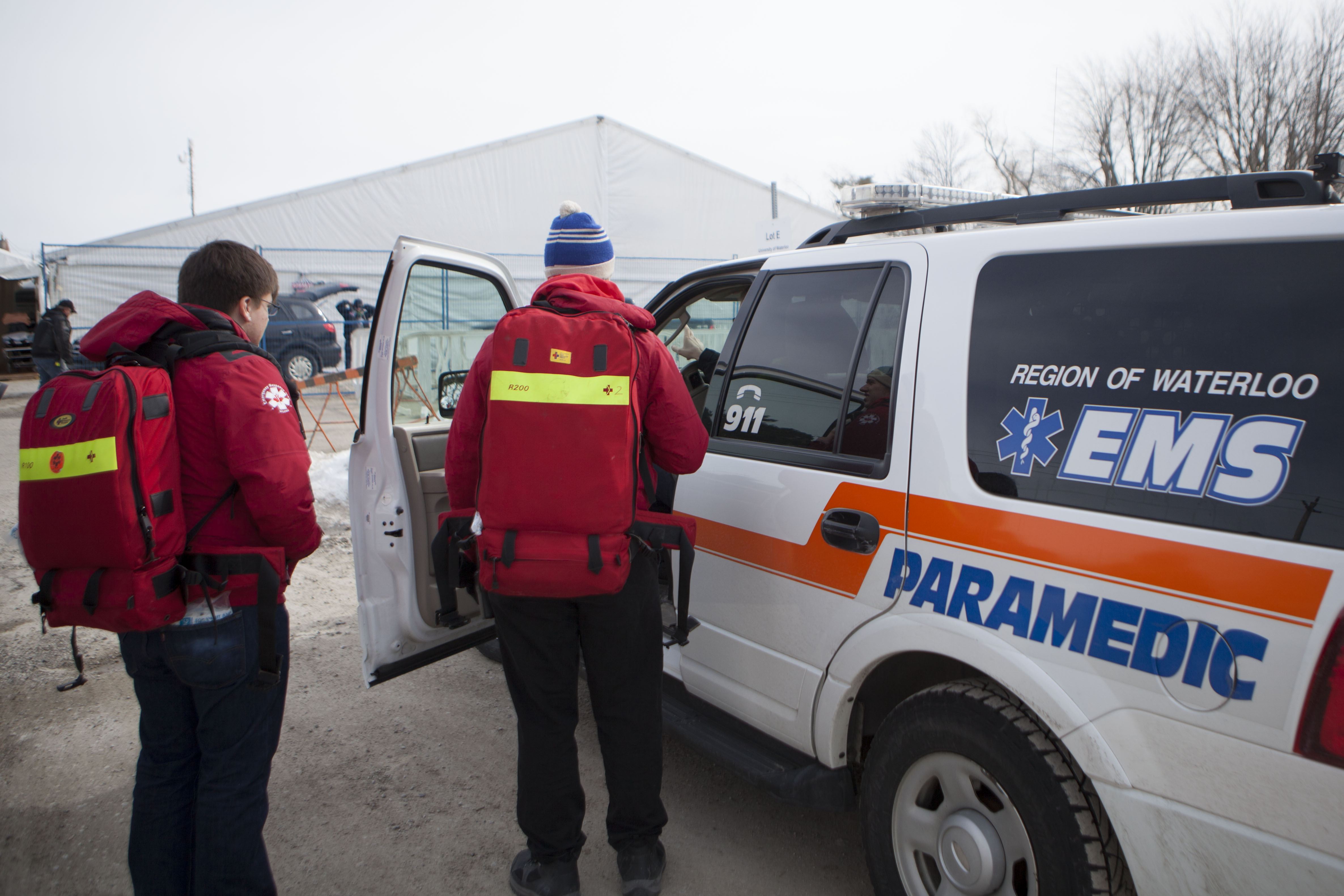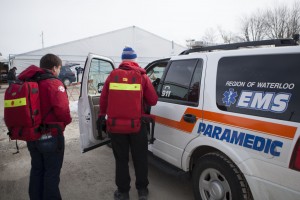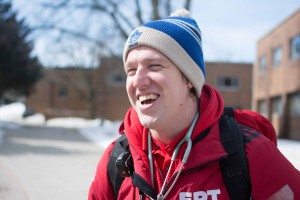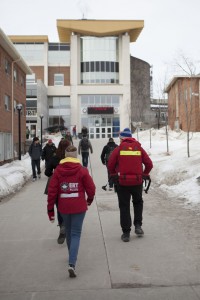Laurier’s first responders


It’s a crisp, clear morning on Wilfrid Laurier University’s campus. The low throb of music and the silly, drunken laughter of students carry out from the residences onto the sidewalk, just giving a hint of the debauchery that will soon pour out onto the streets and create one of the busiest days of the year for Laurier’s Emergency Response Team (ERT).
Today is St. Patrick’s Day — one of the biggest drinking events of the year for Waterloo students, who have taken advantage of warmer weather in past years to turn the day into a giant party, culminating in a thousands-strong street celebration close to campus down Ezra Avenue.
“I’m glad I’m not Irish,” says Keegan Goodman, ERT’s coordinator, as he strolls by Laurier’s Euler Residence. Students whoop and holler at him from a third floor window, their attention drawn by his bright red ERT jacket and bulky first responders backpack. He’s used to it — this is his third St. Patrick’s day volunteering as an ERT.
Goodman would rather be working then partying. Already today, he’s had very little sleep, covering for other team members who couldn’t make their shifts.
As the coordinator of ERT, he has seen it all. His team is often the first to respond to on campus medical emergencies, dealing with ailments ranging from homesickness to seizures, acting with the same professionalism expected by their EMS counterparts. And they do it all as volunteers, slotting shifts in between classes and social lives.
They are the responsible ones on a day of irresponsibility because they are filling a need that most campuses didn’t even know they had until fairly recently — helping students before other responders can.
The first North American campus ERT team was formed at McMaster University in 1982 after an undergraduate student named Eddie Wasser became concerned about how long it took EMS to respond to on-campus emergencies.
After getting permission from McMaster’s administration, Wasser started running the team out of his dorm room. Volunteers trained in first aid were able to help people before EMS arrived, or even negate the need for an EMS call altogether.
The idea spread, and before long almost every university in Ontario had an ERT team. The teams also became more professional.

Laurier’s ERT was one of the first schools to require volunteers to have first responder training, an advanced qualification a step beyond basic first aid training. They were also one of the first teams to be integrated into their Students’ Union as a department.
Laurier’s team has almost 50 people on it today. Rookies are recruited in two cycles, one at the end of the school year and one at the beginning. After successfully completing a try-out where they have to show that they have a basic grasp of first aid, they are hired and trained as first responders.
After a period of “shadow shifting” — where they follow more experienced responders on calls — the rookies start taking their own calls. Each shift is worked in pairs. They respond to emergency calls that are directed to them by Laurier’s Special Constables Services (SCS) unit.
Overall their shifts are quiet — some teams use the time as an excuse to do homework, watch movies, and even knit. But some shifts, particularly the overnight ones on Friday and Saturday nights, will see an uptick in emergency calls as students head out to bars and parties. And then there are the shifts where, for no discernable reason, calls come in quickly.
One responder, Jaimie Archer, remembers getting slammed with four calls in one week. “You’re never going to know until it happens,” she says.
Their role takes on added importance as the school gears up for major events. O-Week is described by almost every team member as the craziest week of the year — they get almost as many calls during that one single week as they do the rest of the semester. But big party days like St. Patrick’s and Homecoming also do brisk business in calls, often because people have drank too much.
For this year’s St. Patrick’s celebrations, ERT had teams stationed at the party tent on Seagram Drive and at their office on King St.
Goodman arrives at the tent on Seagram Drive around 11 a.m. with Ciara Ryan, a Foot Patrol team member who will relieve Jordan Brazeau, who’s already been working at the tent alongside Waterloo Region EMS. Waterloo’s EMS invited the ERT to assist during the day.
ERT has become Brazeau’s passion. He listens to the EMS scanner before bed — “just for fun,” he says — and also works for a patient transfer company. He will succeed Goodman as ERT coordinator in 2014-2015.
“Today should be fun,” he says. “Well, fun is relative.” For now, it’s quiet but as the day goes on and people begin to drink, they know they’ll get some calls. Already, the streets are beginning to fill with people making their way parties throughout the neighbourhood.

The reasons for joining the team are as unique as the people who make it up. Hailey Wilcox, a fourth-year biology student at Laurier and self-described cool science nerd, did it because of the pride she has for her university. “I needed to do something because I love this school and I think it’s fantastic.”
As an upperclassman Wilcox joined the team fairly late. Some, like Deanna Lichty were hooked right from first year. “During O-week I saw the response team doing everything in the AC and I thought it looked cool,” Lichty says. “I was a lifeguard and I already had my first aid. I thought another way to apply that knowledge would come in handy.”
A common refrain among the ERT volunteers is their wish to work in health care. At least one alumnus has gone on to medical school, while some, including Brazeau and Goodman, are already focused on becoming paramedics.
But for others, the team is simply a social activity that can help them blow off a little steam. Alex Hughes — or ‘Big Al,’ as he is known around the ERT office — is a history major who will be studying Disney’s role in American culture as part of his Master’s thesis next year.
“I do it for a rush outside of the day-to-day books,” he says. “But it’s funny how this team has become some of my best friends.”
The social aspect is as important to the team members as the experience they are gaining. They all refer to themselves as a “dysfunctional family” — trading inside jokes and happily sharing food with one another. Many find themselves hanging out at the ERT office even if they aren’t on shift. They just enjoy the atmosphere.
On St. Patrick’s Day Hughes, for example, joins Goodman and Brazeau on patrol even though he’s not scheduled. They use the time to catch-up and reminisce about old war stories — according to them, the group of frosh born in 1993 were among the ones with the most calls to date.
Intoxication comes up frequently as one of the reasons for heading out to a call, so much that it has actually taken the gloss off drinking for some of the team members.
“First time you see someone who is really, really fucked up and getting sent off in an ambulance you’re like, ‘why do we drink to excess?’” says Hughes.
O-Week and St. Patrick’s are just more of the same. “It gets repetitive by the end of the week,” says Lichty. “Oh, another drunk call, thanks.”
But ERT does get to work on more unique medical emergencies. When they help out at the Powderpuff football tournament each year, a few sprains and breaks are expected. But this year the responders on duty found themselves dousing triangular bandages in hot water to help treat the cold fingers and toes of the players who were competing during the frigid, record-setting lows of the polar vortex.
However, the ERT has seen a dip in total calls in 2014-15 compared to previous years, due to a report commissioned by the Students’ Union that found that while ERT plays an important role at Laurier, their own liability insurance would not necessarily cover the team in the event that they were sued if, for example, someone’s ribs were broken in the course of doing incorrectly performed CPR.
As a result, SCS had to reduce the amount of calls they were sending to ERT.
“It’s in the process of being sorted out right now,” says Brazeau. He’s working with an insurance company to ensure the team is properly covered, and back to taking all the calls it can, for the upcoming school year.
But the news came just as the team was dealing with another big issue — this year ERT also saw their budget slashed from $40,000 to $14,000 because of the $6.5 million debt incurred by the Students’ Union.
But rather than dwell on cuts, Goodman and Brazeau are moving forward. Their goal is to make ERT a self-sustaining entity. They want to start providing first aid trainings for students and the community, as part of an effort to engage more people.
“Biggest thing we want to be able to do is meet and help as many students as we can,” says Goodman. “We want to be the best response team in Canada.”
He believes that ERT plays an important role in keeping campus safe. Goodman points out that ERT can reach most situations on campus within two minutes — the average for EMS is nine depending on the severity of the incident.
In situations where minutes are crucial, having ERT on the scene can be the difference between a victim having to make a hospital trip or getting to return to their own home.
On St. Patrick’s Day, this becomes clear as the afternoon rolls on. By 5 p.m., ERT has responded to three calls — two people who passed out and one allergic reaction. Before the campus team — Morgan Glass and Nicole Martin — can even take their backpacks off at the office, another call is being radioed in. A man is vomiting and appears unconscious on campus.
When they reach the victim, it becomes clear how well-trained the pair are. They calmly approach the man, who is bent over a table, and roust him.
Martin starts asking him an almost never ending list of questions while Glass checks the victim’s vital signs, kindly asking for permission while he checks the victim’s blood pressure and feels his head for any cuts or bruising.
The key is the questioning — the teams carry with them a thorough incident report that requires they check for a variety of conditions to rule out any other ailments. Keeping the victim talking also allows the team to assess how responsive he is.
It soon becomes clear that while he may have had too much to drink, the victim won’t do any harm to himself or anyone else and understands where he is and what happened — he just decided to take a quick nap on campus.
Martin asks if he wants accompaniment home but he refuses. The team advises the victim that if he does require help, he can call them back.
When asked what they most like about being on ERT, the responders almost universally say the same thing: they like helping people.
“It’s exciting to use a skill set you’ve developed over time to help somebody out,” says Hughes.
“There is some sort of degree of fun to that.”
When police finally clear Ezra St. at 7 p.m., it seems like the St. Patrick’s fun is over. But the ERT’s night isn’t over. They’ll go out on one more call, to one of the residences to treat an intoxicated student.
They’re out helping people because that’s what they do.

